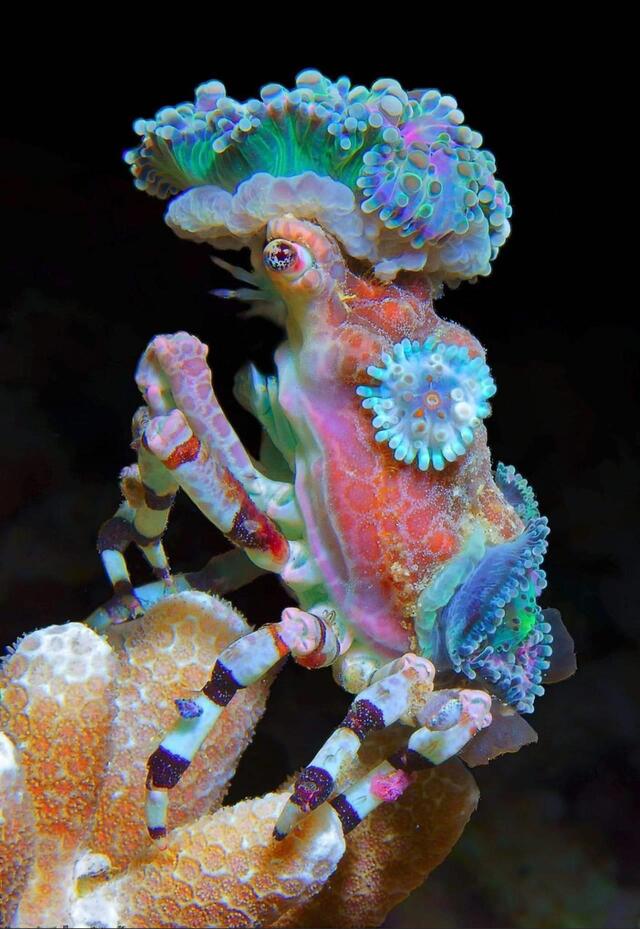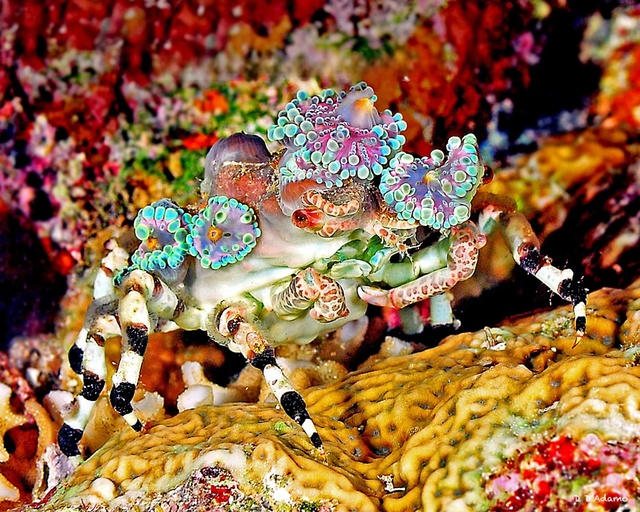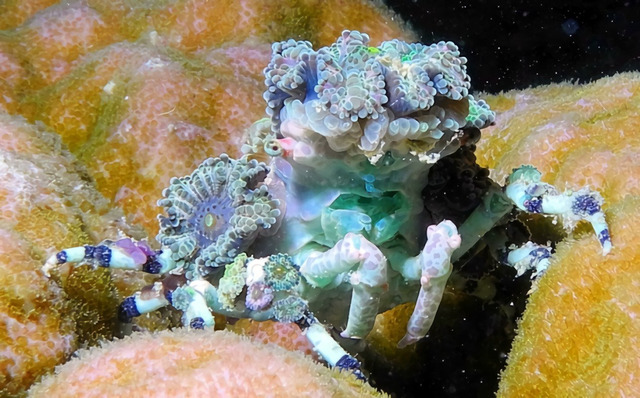The Corallimorph Decorator Crab (Cyclocoeloma tuberculata), also known as the Decorator Spider Crab, Teddy Bear Crab, or Tubercle Crab, By covering their bodies with poisonous sea life they absorb their toxins into themselves, becoming venomous as well, hence their "poison" typing,is a fascinating marine creature found in the Indo-Pacific. Its unique behavior of adorning itself with marine organisms has captured the attention of marine biologists and underwater enthusiasts alike. This article delves into the habitat, morphology, behavior, and ecological role of this intriguing species.
Kingdom: Animalia
Phylum: Arthropoda
Class: Malacostraca
Order: Decapoda
Infraorder: Brachyura (True Crabs)
Family: Inachidae
Genus: Cyclocoeloma
Species: Cyclocoeloma tuberculata
The Corallimorph Decorator Crab (Cyclocoeloma tuberculata) belongs to the Brachyura infraorder, which includes "true crabs." It is part of the Inachidae family, known for its ability to camouflage by attaching marine organisms such as corallimorphs to its exoskeleton.

The Corallimorph Decorator Crab (Cyclocoeloma tuberculata) is a member of the Brachyura order, commonly referred to as "true crabs." These crabs are distinguished by their short abdomen, four pairs of walking legs, and a pair of clawed arms. Despite their small size, reaching a maximum length of 5 cm, these crabs are masters of disguise.
The Corallimorph Decorator Crab’s body is covered in tubercles and fine hair, making it an ideal surface for marine organisms like corallimorphs and algae to attach. This natural camouflage is its primary defense mechanism against predators.
Size: Up to 5 cm in length.
Structure: Features four pairs of walking legs and clawed front arms.
Coloration: Varies based on the organisms used for decoration, blending seamlessly into the coral or rocky reef environment.
The Corallimorph Decorator Crab thrives in shallow lagoons, intertidal zones, and coral and rocky reefs with abundant algal growth. It prefers hard substrates that support a rich diversity of marine life, which it utilizes for camouflage.
Depth Range: Found between 1-10 meters underwater.
Geographical Distribution: Widespread across the Indo-Pacific, from the shallow waters of Southeast Asia to the reefs of the Indian Ocean.
What sets the Corallimorph Decorator Crab apart is its behavior of "decorating" itself. It actively picks up marine organisms, such as corallimorphs, sponges, and algae, and attaches them to its exoskeleton using hooked bristles (setae). This creates an almost seamless camouflage, helping it avoid predators like fish and octopuses.

The Corallimorph Decorator Crab is omnivorous, feeding primarily on algae and zooplankton. Its opportunistic diet supports its survival in diverse reef ecosystems.
The Corallimorph Decorator Crab (Cyclocoeloma tuberculata) plays a vital role in maintaining the health of coral reef ecosystems:
Predator Avoidance: Its camouflage reduces the population pressure on predators.
Algal Control: By consuming algae, it helps prevent algal overgrowth on coral reefs, maintaining the balance of the ecosystem.
Biodiversity Support: The organisms it carries on its back, such as corallimorphs and sponges, benefit from increased exposure to nutrients and light.
Custom Camouflage: Unlike other decorator crabs, the Corallimorph Decorator Crab often relies heavily on corallimorphs, giving it a distinct appearance and name.
Wide Range: Despite its small size, its distribution across the Indo-Pacific is extensive, highlighting its adaptability.
Tiny Architects: These crabs meticulously select their "decorations" for both camouflage and potential protection, such as corallimorphs with stinging cells.
While the Corallimorph Decorator Crab is not currently classified as endangered, its habitat—coral reefs—is under significant threat due to:
Climate Change: Rising sea temperatures and ocean acidification harm coral reef ecosystems.
Overfishing: The decline of coral reef biodiversity impacts the food web, indirectly affecting crabs.
Pollution: Coastal pollution reduces the availability of hard substrates and marine organisms that the crab depends on for camouflage.
Preserving coral reef ecosystems is crucial for the survival of species like the Corallimorph Decorator Crab (Cyclocoeloma tuberculata).

To spot this elusive creature during a dive:
Look for moving patches of corallimorphs or algae on coral reefs.
Observe shallow lagoons and rocky reef areas with abundant marine growth.
Dive at depths of 1-10 meters, where these crabs are most commonly found.
The crab gets its name from its habit of covering itself with corallimorphs and other marine organisms as a camouflage strategy.
No, but their coral reef habitats are increasingly under threat, making conservation efforts essential.
They primarily feed on algae and zooplankton, making them important contributors to reef ecosystem health.
The Corallimorph Decorator Crab (Cyclocoeloma tuberculata) is a marvel of marine adaptation. Its unique ability to blend into its environment using natural decorations highlights the incredible biodiversity of coral reef ecosystems. Protecting its habitat is essential not just for the survival of this species, but for the health of the entire Indo-Pacific marine ecosystem.
For marine enthusiasts, spotting the Corallimorph Decorator Crab is a reminder of nature’s ingenuity, showcasing the incredible adaptations life has evolved to thrive in challenging environments.
References:
"Marine Biodiversity in the Indo-Pacific Region." Journal of Marine Biology, 2021.
Smith, J., & Brown, R. "Decorator Crabs and Their Camouflage Techniques." Reef Ecology Studies, 2019.
NOAA Coral Reef Conservation Program. "Threats to Coral Reefs."
animal tags: Inachidae
We created this article in conjunction with AI technology, then made sure it was fact-checked and edited by a Animals Top editor.